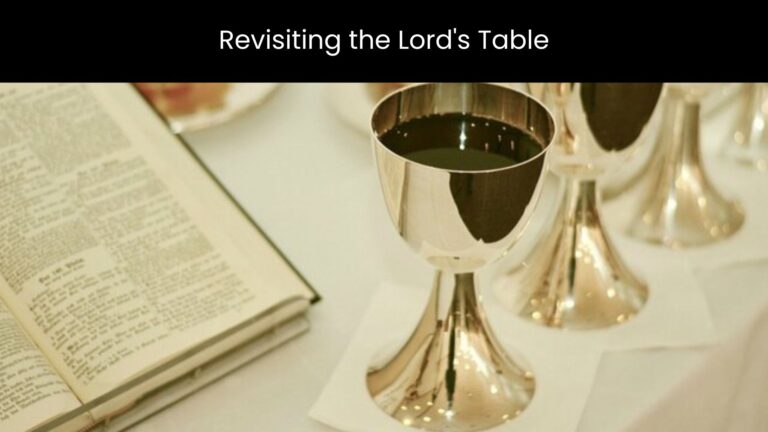Revisiting the Lord’s Table – Again and Again
“Jesus took bread, and after blessing it, broke it and gave it to the disciples, and said, “Take, eat; 1 this is my body.” And he took a cup, and when he had given thanks he gave it to them, saying, “Drink of it, all of you, for this is my blood of the covenant, which is poured out for many for the forgiveness of sins.”
With these words, Matthew records the historic moment when Jesus instituted a simple but profound meal that has been a central practice of the church for the past 2,000 years. While its practice has a myriad of applications in terms of who participates, what the actual food components are, and how often it is shared, no one denies its significance as central to the mission and message of Jesus.
The practice of bread and cup is still a significant part of life in the Anabaptist church. As with most traditions, it’s easy to merely see this from inside our denomination’s long habit of practice. We rarely take a moment to step back and have a look at its place in the history of salvation, the life of the church over the past two thousand years and even its place in the Anabaptist denominations. The way in which it is practiced feels “normative” to us and seldom comes under scrutiny.
For a large segment of Anabaptist churches, the Lord’s supper is served in a specifically designed service two to four times per year. It often follows some form of examination: for some a quite formal, full-length service days or weeks before, and for others a more abbreviated segment of a service. Common to most is preparation that emphasizes the serious nature of this event.
What has been debated throughout Anabaptist history is who comes to the table. Is it for the local church only? For the local church and visitors from the same family of churches? Is the table open to all believers? Terms have been coined to describe the various practices such as open, close, and closed. These views represent something of the polity of the church and also often represent the congregation’s perspective on navigating the challenging terrain of holiness and unity.
What has received relatively little attention is the role of this event in the life of the church. No one disputes the significance of the supper as a three-fold reminder: the historic death of Jesus, our personal salvation through this work of Jesus, and anticipation of His return when we will share this meal with Him again in the newly redeemed world. It clearly is a reminder.
Much energy has been invested in the role of discipline and discipleship to the point that many feel some deep sense of dread and foreboding (fear) coming to the table, rooted in a concern that they may be “eating and drinking unworthily” and come under the judgment of the Lord. This is a real possibility but likely not for the reasons many fear.
Over the past years, I have become increasingly more aware of the centrality of the table to the work and message of Jesus. It seems as though revisiting this central rite of the church is long overdue: revisiting its purpose, role, and practice, not only in biblical study and theological significance, but also in frequency of practice. We would do well to revisit it with careful attention.
The frequency of practice is in need of attention. One of the earliest Anabaptist confessions, the Schleitheim confession of faith, has a section called “Congregational Order” in which believers are urged (section 1) to “Meet at least three or four times a week to exercise themselves in the teaching of Christ.” Section seven informs them that “the Lord’s supper shall be held as often as they are together.”2 Maybe a very Anabaptist thing to do would be to increase the frequency with which we come to the Lord’s table together to remember the central message of Jesus’s death and resurrection. It seems apparent from the Gospel of John that Jesus also intends for this meal to be a reminder of how we are sustained on our earthly pilgrimage.
The most common objection I hear is that increased frequency would diminish the significance and importance of communion. I would argue that the very nature of the meal is intended to be one of frequency – this was not a meal of festival, such as rib-eye steak and lobster, but rather one most central to human existence: bread and wine.
Second, rather than seeing the meal as a rare and special event, it seems to have closer correlation to the family dinner. This is a meal that is at the very center of healthy family life – physically and emotionally. Our hearts should leap with anticipation when we hear the voice of the pastor say, “Come to the table of the Lord. The bread and wine are served,” just as we do when we hear the welcome voice of the cook at the end of a long day, “Dinner’s served!”
The table of the Lord deserves to be revisited for its theological significance to twenty-first century church life. It deserves to be revisited so that the Jesus of the table will nurture and sustain us in our wilderness journey as the manna from heaven. Maybe we should revisit it again and again.
11 Cor. 10:16; [John 6:53] Return to context⬏
Tags:








Dwight Gingrich
6 years ago
Yes! How ironic that, on the one hand, we sometimes say increased frequency would diminish the significance and joy of communion and yet, on the other hand, too often our experiences of communion have been marked by fear and dread. May we be refreshed together often at the table and not withhold this important blessing from our brothers and sisters.